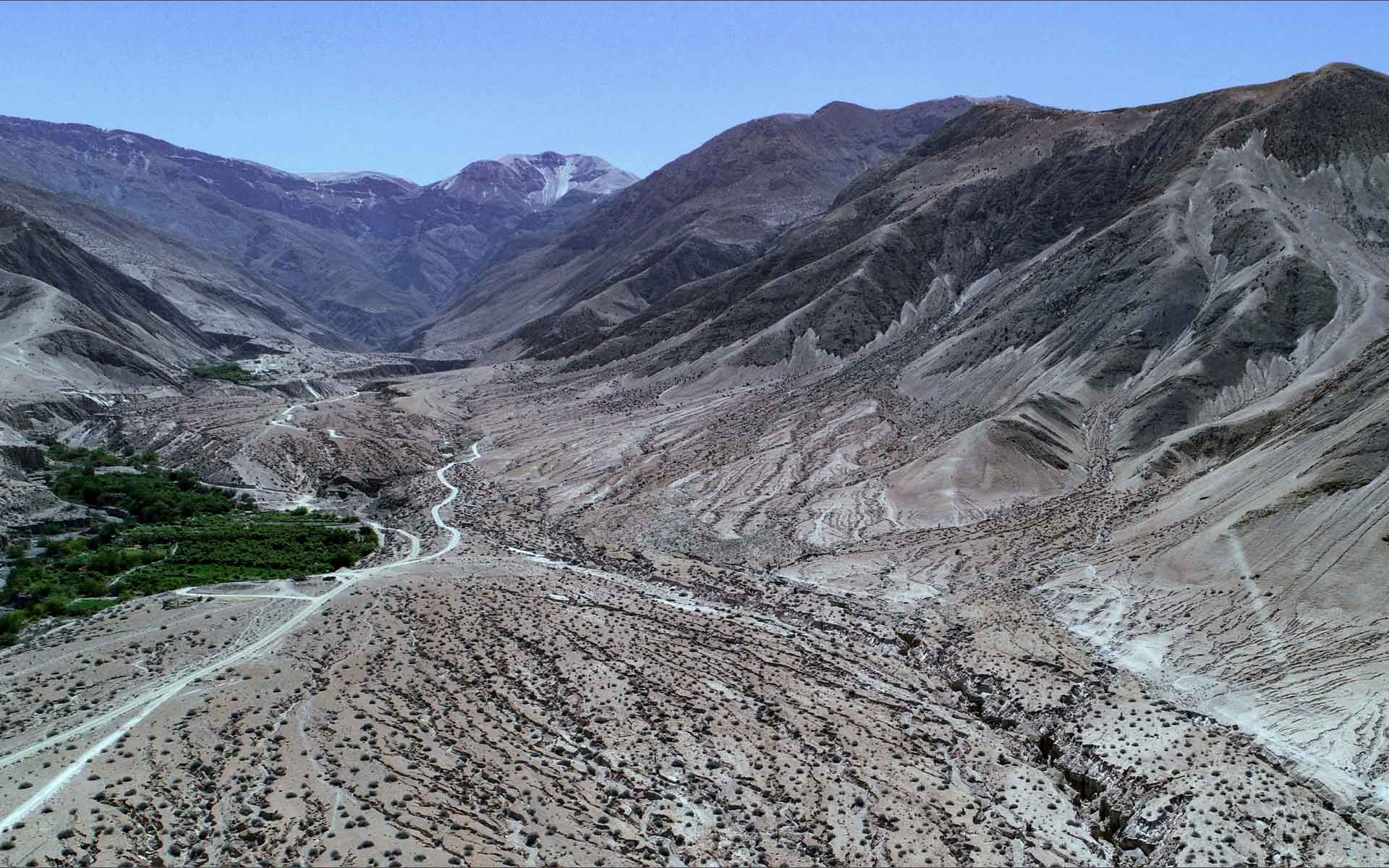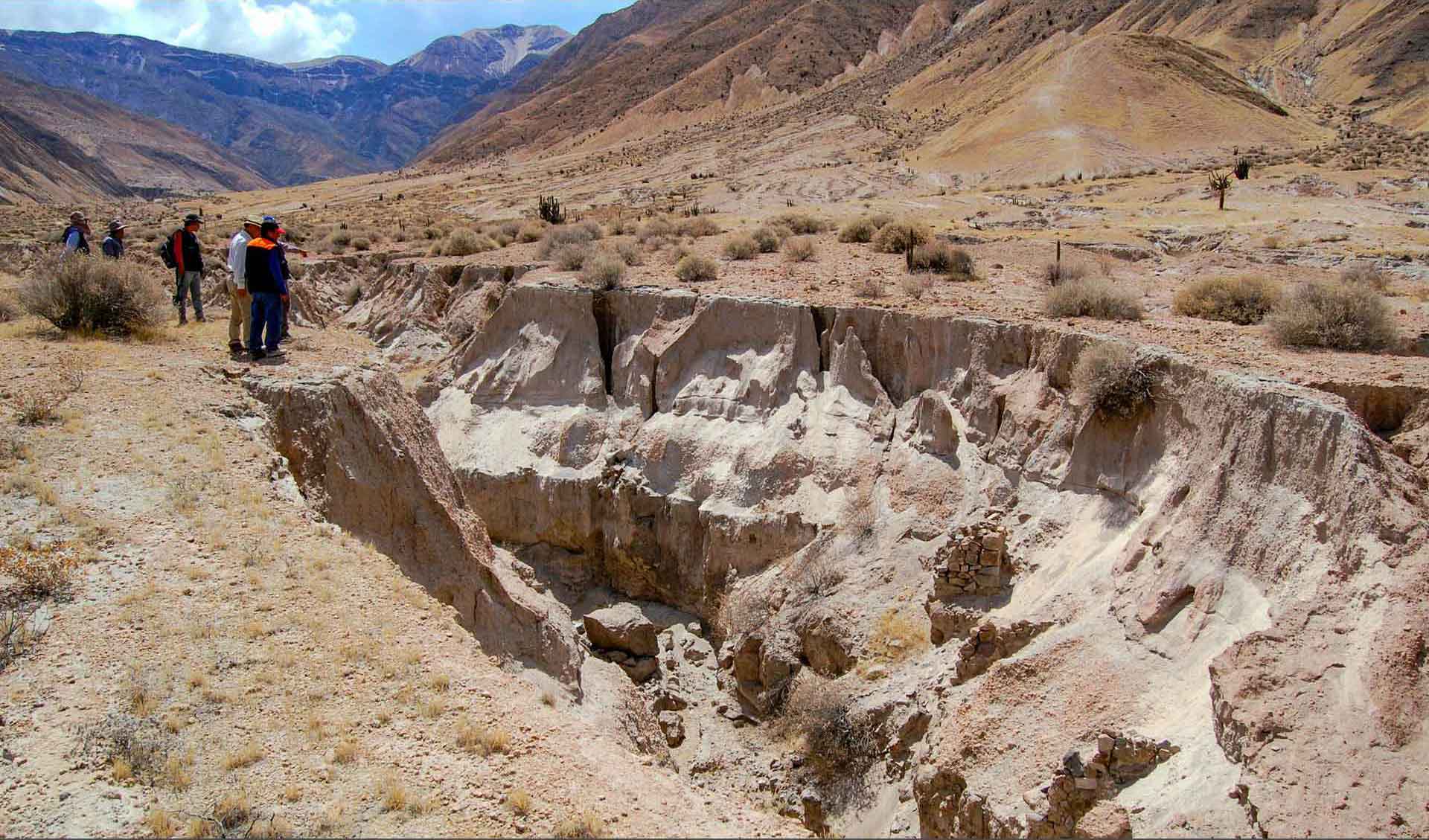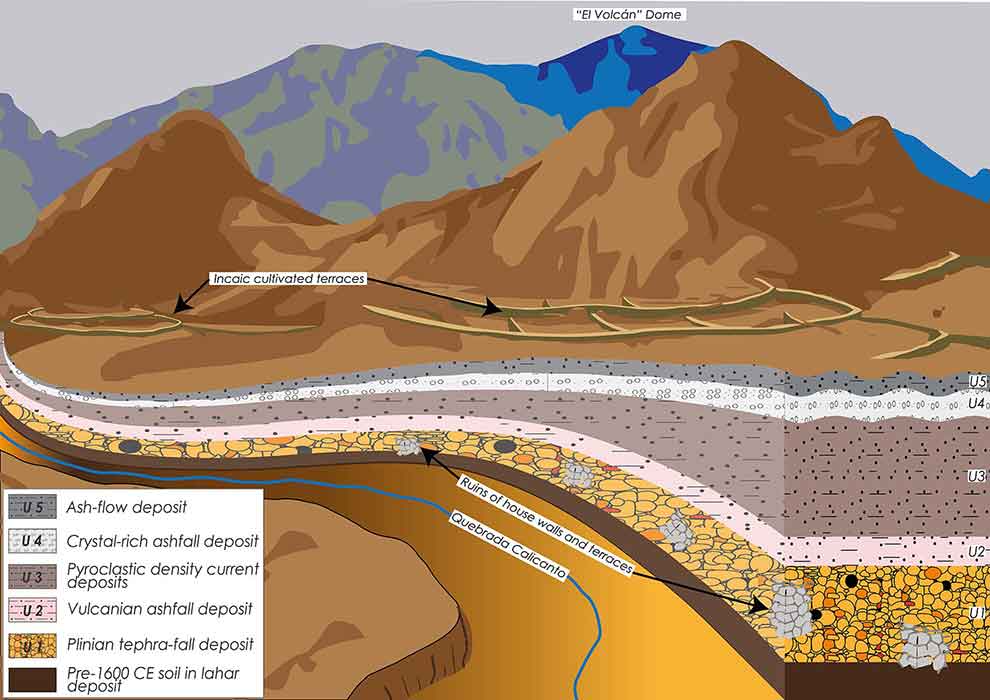The Calicanto pyroclastic succession of the 1600 CE Huaynaputina eruption
PERU

Pyroclastic density current and tephra deposits from the 1600 CE Huaynaputina eruption in the area of the Calicanto geosite, southeast edge of the Quebrada (valley) del Volcan.
Geological Period
Late Holocene
Main geological interest
Volcanology
Geoarchaeology
Location
Department of Moquegua, Southern Peru.
16°44’07.0″S, 70°51’38.0″W
Pyroclastic density current and tephra deposits from the 1600 CE Huaynaputina eruption in the area of the Calicanto geosite, southeast edge of the Quebrada (valley) del Volcan.
The pyroclastic deposits of the largest historical volcanic eruption in South America preserved in the inca village of Calicanto.
The 1600 CE eruption of Huaynaputina is considered the most voluminous (VEI 6) that occurred in historical times in South America and one of the largest in the world over the past 1,500 years. The eruption had an impact on the global climate, as it triggered a temperature drop of -1.13 °C in 1601 in the northern hemisphere (Stoffel et al., 2015). At the more regional scale, this eruption buried at least a dozen Inca villages, causing perhaps 1,500 fatalities, and disrupting the early Colonial economy in Peru for years. The Calicanto geosite is therefore a geological and cultural reference.
- Geological description
Huaynaputina, southern Peru, is an active volcano of the Central Andean Volcanic Zone. Huaynaputina is built of two edifices: a stratovolcano (Pleistocene) overlain by a dome cluster and a group of vents (Late Pleistocene-Holocene) within a horsehoed-shaped scar.
The 1600 CE explosive eruption of the Huaynaputina volcano produced a range of pyroclastic deposits with an average thickness of ~3 m at the geosite. The pyroclastic sequence shows five units: a Plinian tephra fall deposit (U1), Vulcanian ashfall deposits (U2), Pyroclastic density current deposits (U3), Crystal-rich ashfall deposit (U4) and Ash flow deposit (U5) (Thouret et al., 2002; Prival et al., 2020). Tephrostratigraphy conducted at this geosite and its surroundings allowed the eruptive processes to be reconstructed and Plinian eruptions to be better understood.
The Inca Calicanto town, located 13 km south of Huaynaputina near the village of Quinistaquillas, was one of a dozen of villages buried by this event. Study of the ruins and damage on the structures help understand the impact of the pyroclastic deposits on houses and Inca cultivated terraces. In an approximate area of 50,000 m2, we identified about 20 edifice walls and 21 Inca terraces mantled by pyroclastic deposits (Mariño et al., 2021; Arias, 2021; INGEMMET, 2021).
- Scientific research and tradition
The first investigation period (1995-2002) dealt with the tephrostratigraphy and the analysis of chronicles, aiming at reconstructing the evolution of the 1600 CE eruption. From 2015 to the present, multidisciplinary studies (mapping, geophysical surveys, etc.) have examined the impacts of the eruption and have studied the geoheritage in Calicanto and other sites (Arias, 2021; Marino et al., 2021).
- Reference
Arias Salazar, C.L. (2021) Recursos geoturísticos generados a partir del impacto de la erupción del volcán Huaynaputina del año 1600 d.C. como patrimonio geológico. Thesis. Universidad Nacional del Altiplano. Available at: http://repositorio.unap.edu.pe/handle/UNAP/15619.
Instituto Geológico Minero y Metalúrgico Dirección de Geología Ambiental y Riesgo Geológico (2021) Patrimonio geológico asociado a la erupción del volcán Huaynaputina del año 1600 d.C. en el distrito de Quinistaquillas. Provincia General Sánchez Cerro, departamento Moquegua. Informe técnico N° A7184. Perú: Instituto Geológico Minero y Metalúrgico. Dirección de Geología Ambiental y Riesgo Geológico, p. 57. Available at: https://repositorio.ingemmet.gob.pe/handle/20.500.12544/3306.
Mariño, J. et al. (2021) ‘Multidisciplinary Study of the Impacts of the 1600 CE Huaynaputina Eruption and a Project for Geosites and Geo-touristic Attractions’, Geoheritage, 13, p. 64. Available at: https://doi.org/10.1007/s12371-021-00577-5.
Prival, J.-M. et al. (2020) ‘New insights into eruption source parameters of the 1600 CE Huaynaputina Plinian eruption, Peru’, Bulletin of Volcanology, 82(1), p. 7. Available at: https://doi.org/10.1007/s00445-019-1340-7.
Stoffel, M. et al. (2015) ‘Estimates of volcanic-induced cooling in the Northern Hemisphere over the past 1,500 years’, Nature Geoscience, 8(10), pp. 784–788. Available at: https://doi.org/10.1038/ngeo2526.
Thouret, J.-C. et al. (2002) ‘Reconstruction of the AD 1600 Huaynaputina eruption based on the correlation of geologic evidence with early Spanish chronicles’, Journal of Volcanology and Geothermal Research, 115(3), pp. 529–570. Available at: https://doi.org/10.1016/S0377-0273(01)00323-7.
- Author(s)
Jersy Mariño Salazar
Observatorio Vulcanológico, Instituto Geológico Minero y Metalúrgico (INGEMMET), Arequipa, Perú
Carla Arias Salazar
Observatorio Vulcanológico, Instituto Geológico Minero y Metalúrgico (INGEMMET), Arequipa, Perú
Kevin Cueva Sandoval
Observatorio Vulcanológico, Instituto Geológico Minero y Metalúrgico (INGEMMET), Arequipa, Perú
Jean-Claude Thouret
Université Clermont Auvergne, Laboratoire Magmas et Volcans, OPGC, CNRS et IRD, Clermont Ferrand, France
Bilverto Zavala Carrión
Instituto Geológico Minero y Metalúrgico-INGEMMET
Antony Finizola
Laboratoire Géosciences Réunion, Université de La Réunion, F 97744 Saint Denis, France & Université de Paris, Institut de Physique du Globe de Paris, CNRS, F 75005 Paris, France
Raphael Antoine
Centre d’études et d’expertise sur les risques, l’environnement, la mobilité et l’aménagement (CEREMA), Rouen, France
Eric Delcher
Laboratoire Géosciences Réunion, Université de La Réunion, F 97744 Saint Denis, France & Université de Paris, Institut de Physique du Globe de Paris, CNRS, F 75005 Paris, France
Cyrille Fauchard
Centre d’études et d’expertise sur les risques, l’environnement, la mobilité et l’aménagement (CEREMA), Rouen, France
Franck Donnadieu
Université Clermont Auvergne, Laboratoire Magmas et Volcans, OPGC, CNRS et IRD, Clermont Ferrand, France
Philippe Labazuy
Université Clermont Auvergne, Laboratoire Magmas et Volcans, OPGC, CNRS et IRD, Clermont Ferrand, France
Saida Japura
Observatorio Vulcanológico, Instituto Geológico Minero y Metalúrgico (INGEMMET), Arequipa, Perú
Rachel Gusset
Laboratoire Géosciences Réunion, Université de La Réunion, F 97744 Saint Denis, France
Paola Sanchez
Observatorio Vulcanológico, Instituto Geológico Minero y Metalúrgico (INGEMMET), Arequipa, Perú
Domingo Ramos
Observatorio Vulcanológico, Instituto Geológico Minero y Metalúrgico (INGEMMET), Arequipa, Perú
Liliane Thouret
École Edgar Quinet, Éducation nationale, Clermont Ferrand, France
Thibault Saintenoy
Laboratoire AiHP GEODE, Université des Antilles, 97233 Schoelcher, France & Instituto de Ciencias del Patrimonio, Consejo Superior de Investigaciones Científicas, 15705 Santiago de Compostela, Spain
Benjamin van Wyk de Vries
Université Clermont Auvergne, Laboratoire Magmas et Volcans, OPGC, CNRS et IRD, Clermont Ferrand, France
Andy Ancalle Quispe
Observatorio Vulcanológico, Instituto Geológico Minero y Metalúrgico (INGEMMET), Arequipa, Perú


